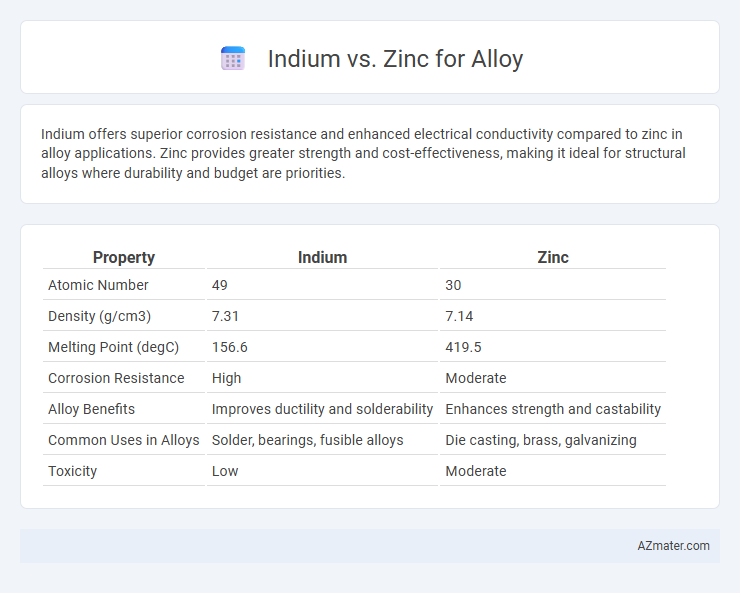Indium offers superior corrosion resistance and enhanced electrical conductivity compared to zinc in alloy applications. Zinc provides greater strength and cost-effectiveness, making it ideal for structural alloys where durability and budget are priorities.
Table of Comparison
| Property | Indium | Zinc |
|---|---|---|
| Atomic Number | 49 | 30 |
| Density (g/cm3) | 7.31 | 7.14 |
| Melting Point (degC) | 156.6 | 419.5 |
| Corrosion Resistance | High | Moderate |
| Alloy Benefits | Improves ductility and solderability | Enhances strength and castability |
| Common Uses in Alloys | Solder, bearings, fusible alloys | Die casting, brass, galvanizing |
| Toxicity | Low | Moderate |
Introduction to Indium and Zinc Alloys
Indium and zinc are essential metals used in alloy production with distinct properties influencing their applications. Indium alloys offer excellent corrosion resistance, low melting points, and malleability, making them ideal for solders, coatings, and advanced electronics. Zinc alloys provide high strength, wear resistance, and are widely used in die-casting and galvanizing, contributing to automotive, construction, and consumer goods industries.
Chemical and Physical Properties Comparison
Indium exhibits a low melting point of 156.6degC and excellent malleability, making it ideal for low-temperature solder alloys, while zinc has a higher melting point of 419.5degC and offers greater strength and corrosion resistance in alloy applications. Chemically, indium is more inert with high resistance to oxidation, whereas zinc readily forms protective oxide layers that enhance durability. The difference in atomic size and electrochemical potential between indium (atomic number 49) and zinc (atomic number 30) influences alloy behavior, affecting conductivity and mechanical properties.
Alloy Formation: Indium vs Zinc
Indium forms alloys with excellent malleability and low melting points, making it ideal for applications requiring precise thermal control and flexible bonding. Zinc alloys exhibit superior strength and corrosion resistance, commonly used in die casting and galvanization industries. The choice between indium and zinc for alloy formation depends on the balance between ductility and mechanical robustness desired in the final product.
Melting Points and Thermal Behavior
Indium alloys typically exhibit lower melting points around 156.6degC compared to zinc alloys which melt near 419.5degC, making indium suitable for low-temperature applications. The thermal expansion of indium is higher, leading to better flexibility and thermal shock resistance in alloys, while zinc alloys provide greater thermal conductivity and mechanical strength at elevated temperatures. Choosing between indium and zinc alloys depends on required operating temperatures and thermal performance criteria in industrial or electronic applications.
Corrosion Resistance in Different Environments
Indium alloys exhibit superior corrosion resistance in marine and acidic environments compared to zinc alloys, which tend to corrode more rapidly due to zinc's higher electrochemical reactivity. Zinc alloys perform well in moderately alkaline conditions but are more susceptible to oxidation and pitting corrosion under prolonged exposure to moisture and chlorides. Indium's ability to form protective oxide films enhances its durability in aggressive industrial atmospheres, making it preferable for applications requiring long-term corrosion resistance.
Mechanical Strength and Ductility
Indium alloys exhibit lower mechanical strength but significantly higher ductility compared to zinc alloys, making them ideal for applications requiring flexibility and deformation without failure. Zinc alloys generally provide superior tensile strength and hardness, suitable for load-bearing parts and structural applications where mechanical resilience is critical. The choice between indium and zinc alloys depends on the balance needed between durability and malleability in the end-use environment.
Applications in Electronics and Industry
Indium alloys excel in electronics due to their exceptional electrical conductivity and low melting points, making them ideal for soldering and thermal interface materials in semiconductors and LCDs. Zinc alloys are favored in industry for their strength, corrosion resistance, and cost-effectiveness, commonly used in die casting, automotive parts, and galvanization. Indium's rarity and superior thermal properties contrast with zinc's widespread availability and mechanical durability, influencing their selection based on specific electronic or industrial application requirements.
Cost and Availability of Indium and Zinc
Indium is significantly more expensive than zinc due to its rarity and limited global production, with prices often exceeding thousands of dollars per kilogram compared to zinc's more affordable range of a few dollars per kilogram. Zinc is widely available, produced in large quantities worldwide, primarily as a byproduct of mining for other metals such as lead and copper, making it economically viable for alloy production. The high cost and limited supply of indium restrict its use to specialized applications, whereas zinc's abundance and low cost make it a preferred choice for large-scale alloy manufacturing.
Environmental Impact and Recycling
Indium alloys exhibit lower environmental toxicity and easier recyclability compared to zinc-based alloys, primarily due to indium's higher corrosion resistance and stable chemical properties. Zinc promotes faster degradation which can lead to increased soil and water contamination through zinc leachates, while indium's rare occurrence requires efficient recycling processes to mitigate resource depletion. Advances in recycling technologies enhance indium recovery rates above 85%, making it a more sustainable choice for high-performance electronic and solder alloys than zinc, which often suffers from lower recycling efficiency and higher environmental burden.
Choosing the Right Alloy: Key Considerations
Indium alloys provide exceptional thermal and electrical conductivity with excellent corrosion resistance, making them ideal for specialized electronics and soldering applications. Zinc alloys offer superior strength, durability, and cost-effectiveness, commonly used in die casting and structural components. Key considerations include thermal requirements, mechanical properties, and budget constraints to select the optimal alloy for specific industrial uses.

Infographic: Indium vs Zinc for Alloy
 azmater.com
azmater.com